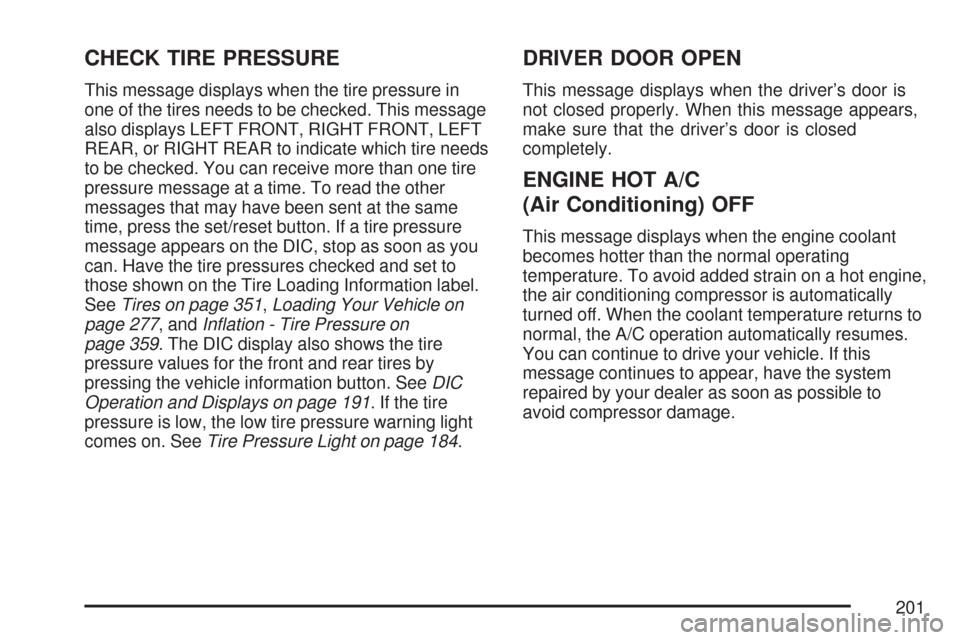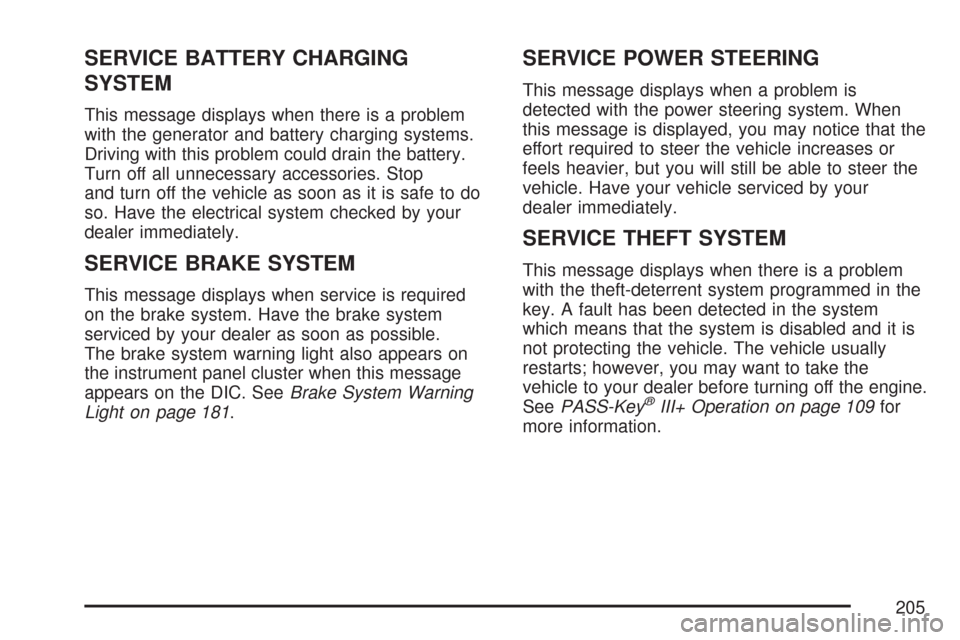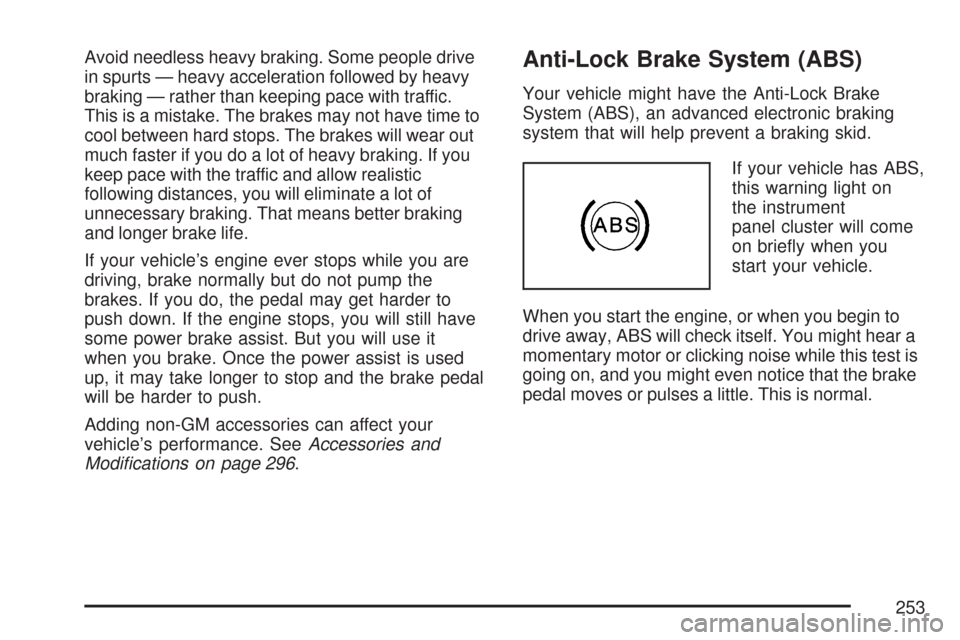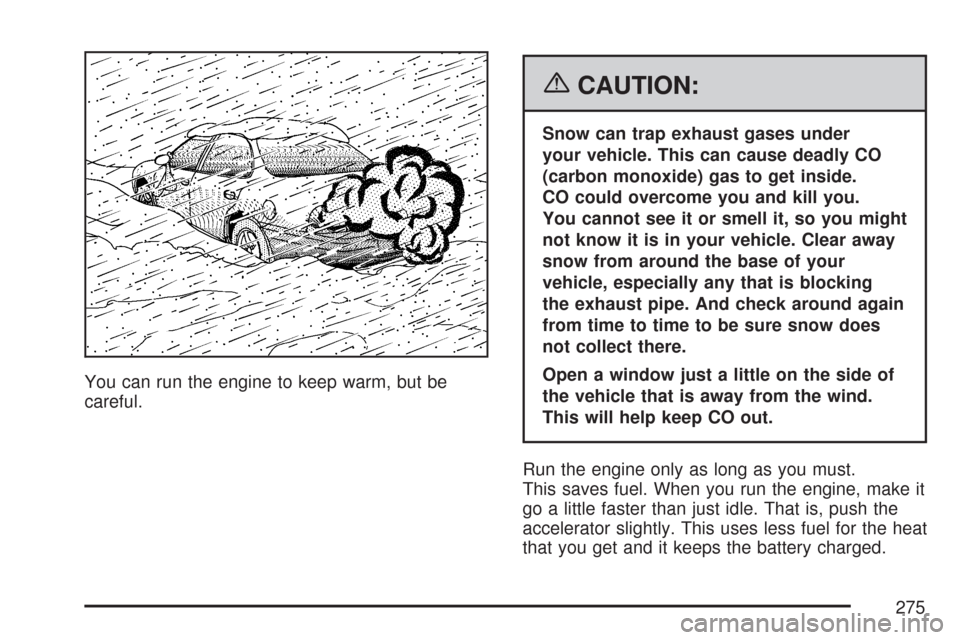2007 CHEVROLET IMPALA check engine light
[x] Cancel search: check engine lightPage 201 of 460

CHECK TIRE PRESSURE
This message displays when the tire pressure in
one of the tires needs to be checked. This message
also displays LEFT FRONT, RIGHT FRONT, LEFT
REAR, or RIGHT REAR to indicate which tire needs
to be checked. You can receive more than one tire
pressure message at a time. To read the other
messages that may have been sent at the same
time, press the set/reset button. If a tire pressure
message appears on the DIC, stop as soon as you
can. Have the tire pressures checked and set to
those shown on the Tire Loading Information label.
SeeTires on page 351,Loading Your Vehicle on
page 277, andIn�ation - Tire Pressure on
page 359. The DIC display also shows the tire
pressure values for the front and rear tires by
pressing the vehicle information button. SeeDIC
Operation and Displays on page 191. If the tire
pressure is low, the low tire pressure warning light
comes on. SeeTire Pressure Light on page 184.
DRIVER DOOR OPEN
This message displays when the driver’s door is
not closed properly. When this message appears,
make sure that the driver’s door is closed
completely.
ENGINE HOT A/C
(Air Conditioning) OFF
This message displays when the engine coolant
becomes hotter than the normal operating
temperature. To avoid added strain on a hot engine,
the air conditioning compressor is automatically
turned off. When the coolant temperature returns to
normal, the A/C operation automatically resumes.
You can continue to drive your vehicle. If this
message continues to appear, have the system
repaired by your dealer as soon as possible to
avoid compressor damage.
201
Page 205 of 460

SERVICE BATTERY CHARGING
SYSTEM
This message displays when there is a problem
with the generator and battery charging systems.
Driving with this problem could drain the battery.
Turn off all unnecessary accessories. Stop
and turn off the vehicle as soon as it is safe to do
so. Have the electrical system checked by your
dealer immediately.
SERVICE BRAKE SYSTEM
This message displays when service is required
on the brake system. Have the brake system
serviced by your dealer as soon as possible.
The brake system warning light also appears on
the instrument panel cluster when this message
appears on the DIC. SeeBrake System Warning
Light on page 181.
SERVICE POWER STEERING
This message displays when a problem is
detected with the power steering system. When
this message is displayed, you may notice that the
effort required to steer the vehicle increases or
feels heavier, but you will still be able to steer the
vehicle. Have your vehicle serviced by your
dealer immediately.
SERVICE THEFT SYSTEM
This message displays when there is a problem
with the theft-deterrent system programmed in the
key. A fault has been detected in the system
which means that the system is disabled and it is
not protecting the vehicle. The vehicle usually
restarts; however, you may want to take the
vehicle to your dealer before turning off the engine.
SeePASS-Key
®III+ Operation on page 109for
more information.
205
Page 253 of 460

Avoid needless heavy braking. Some people drive
in spurts — heavy acceleration followed by heavy
braking — rather than keeping pace with traffic.
This is a mistake. The brakes may not have time to
cool between hard stops. The brakes will wear out
much faster if you do a lot of heavy braking. If you
keep pace with the traffic and allow realistic
following distances, you will eliminate a lot of
unnecessary braking. That means better braking
and longer brake life.
If your vehicle’s engine ever stops while you are
driving, brake normally but do not pump the
brakes. If you do, the pedal may get harder to
push down. If the engine stops, you will still have
some power brake assist. But you will use it
when you brake. Once the power assist is used
up, it may take longer to stop and the brake pedal
will be harder to push.
Adding non-GM accessories can affect your
vehicle’s performance. SeeAccessories and
Modi�cations on page 296.Anti-Lock Brake System (ABS)
Your vehicle might have the Anti-Lock Brake
System (ABS), an advanced electronic braking
system that will help prevent a braking skid.
If your vehicle has ABS,
this warning light on
the instrument
panel cluster will come
on brie�y when you
start your vehicle.
When you start the engine, or when you begin to
drive away, ABS will check itself. You might hear a
momentary motor or clicking noise while this test is
going on, and you might even notice that the brake
pedal moves or pulses a little. This is normal.
253
Page 269 of 460

Once you are moving on the freeway, make
certain you allow a reasonable following distance.
Expect to move slightly slower at night.
When you want to leave the freeway, move to the
proper lane well in advance. If you miss your
exit, do not, under any circumstances, stop and
back up. Drive on to the next exit.
The exit ramp can be curved, sometimes quite
sharply. The exit speed is usually posted. Reduce
your speed according to your speedometer, not
to your sense of motion. After driving for any
distance at higher speeds, you may tend to think
you are going slower than you actually are.
Before Leaving on a Long Trip
Make sure you are ready. Try to be well rested.
If you must start when you are not fresh — such as
after a day’s work — do not plan to make too
many miles that �rst part of the journey. Wear
comfortable clothing and shoes you can easily
drive in.Is your vehicle ready for a long trip? If you keep it
serviced and maintained, it is ready to go. If it
needs service, have it done before starting out.
Of course, you will �nd experienced and able
service experts in GM dealerships all across North
America. They will be ready and willing to help
if you need it.
Here are some things you can check before a trip:
Windshield Washer Fluid:Is the reservoir
full? Are all windows clean inside and outside?
Wiper Blades:Are they in good shape?
Fuel, Engine Oil, Other Fluids:Have you
checked all levels?
Lamps:Are they all working? Are the
lenses clean?
Tires:They are vitally important to a safe,
trouble-free trip. Is the tread good enough
for long-distance driving? Are the tires
all in�ated to the recommended pressure?
Weather Forecasts:What is the weather
outlook along your route? Should you
delay your trip a short time to avoid a major
storm system?
Maps:Do you have up-to-date maps?
269
Page 275 of 460

You can run the engine to keep warm, but be
careful.
{CAUTION:
Snow can trap exhaust gases under
your vehicle. This can cause deadly CO
(carbon monoxide) gas to get inside.
CO could overcome you and kill you.
You cannot see it or smell it, so you might
not know it is in your vehicle. Clear away
snow from around the base of your
vehicle, especially any that is blocking
the exhaust pipe. And check around again
from time to time to be sure snow does
not collect there.
Open a window just a little on the side of
the vehicle that is away from the wind.
This will help keep CO out.
Run the engine only as long as you must.
This saves fuel. When you run the engine, make it
go a little faster than just idle. That is, push the
accelerator slightly. This uses less fuel for the heat
that you get and it keeps the battery charged.
275
Page 298 of 460

Adding Equipment to the Outside of
Your Vehicle
Things you might add to the outside of your
vehicle can affect the air�ow around it. This may
cause wind noise and affect windshield washer
performance. Check with your dealer before
adding equipment to the outside of your vehicle.
Fuel
Use of the recommended fuel is an important part
of the proper maintenance of your vehicle. To
help keep the engine clean and maintain optimum
vehicle performance, GM recommends the use
of gasoline advertised as TOP TIER Detergent
Gasoline.
The 8th digit of the Vehicle Identi�cation Number
(VIN) shows the code letter or number that
identi�es your vehicle’s engine. The VIN is at the
top left of the instrument panel. SeeVehicle
Identi�cation Number (VIN) on page 396.
If your vehicle has the 3.5L V6 engine (VIN Code K
only), you can use either regular unleaded gasoline
or ethanol fuel containing up to 85% ethanol (E85);
also seeFuel E85 (85% Ethanol) on page 300.In
all other engines, use only regular unleaded
gasoline.
Gasoline Octane
For all vehicles except those with the 5.3L V8
engine (VIN Code C), use regular unleaded
gasoline with a posted octane rating of 87 or
higher. If the octane rating is less than 87,
you might notice an audible knocking noise
when you drive, commonly referred to as spark
knock. If this occurs, use a gasoline rated at
87 octane or higher as soon as possible.
If you are using gasoline rated at 87 octane
or higher and you hear heavy knocking,
the engine needs service.
If your vehicle has the 5.3L V8 engine
(VIN Code C), use premium unleaded gasoline
with a posted octane rating of 91 or higher.
You can also use regular unleaded gasoline
rated at 87 octane or higher, but your vehicle’s
acceleration could be slightly reduced, and you
might notice a slight audible knocking noise,
commonly referred to as spark knock. If the octane
is less than 87, you might notice a heavy knocking
noise when you drive. If this occurs, use a gasoline
rated at 87 octane or higher as soon as possible.
Otherwise, you could damage the engine. If you are
using gasoline rated at 87 octane or higher and you
hear heavy knocking, the engine needs service.
298
Page 301 of 460

At a minimum, E85 should meet ASTM
Speci�cation D 5798. By de�nition, this means
that fuel labeled E85 will have an ethanol content
between 70% and 85%. Filling the fuel tank with
fuel mixtures that do not meet ASTM speci�cations
can affect driveability and could cause the check
engine light to come on.
To ensure quick starts in the wintertime, the E85
fuel must be formulated properly for your climate
according to ASTM speci�cation D 5798. If you
have trouble starting on E85, it could be because
the E85 fuel is not properly formulated for your
climate. If this happens, switching to gasoline or
adding gasoline to the fuel tank can improve
starting. For good starting and heater efficiency
below 32°F (0°C), the fuel mix in the fuel tank
should contain no more than 70% ethanol. It is best
not to alternate repeatedly between gasoline and
E85. If you do switch fuels, it is recommended that
you add as much fuel as possible — do not add
less than three gallons (11 L) when refueling. You
should drive the vehicle immediately after refueling
for at least seven miles (11 km) to allow the vehicle
to adapt to the change in ethanol concentration.
E85 has less energy per gallon than gasoline,
so you will need to re�ll the fuel tank more often
when using E85 than when you are using gasoline.
SeeFilling the Tank on page 302.Notice:Some additives are not compatible
with E85 fuel and can harm your vehicle’s fuel
system. Do not add anything to E85. Damage
caused by additives would not be covered
by your new vehicle warranty.
Notice:Your vehicle was not designed for
fuel that contains methanol. Do not use
fuel containing methanol. It can corrode metal
parts in the fuel system and also damage
plastic and rubber parts. That damage would
not be covered under your warranty.
Fuels in Foreign Countries
If you plan on driving in another country outside
the United States or Canada, the proper fuel might
be hard to �nd. Never use leaded gasoline or
any other fuel not recommended in the previous
text on fuel. Costly repairs caused by use of
improper fuel would not be covered by your
warranty.
To check the fuel availability, ask an auto club, or
contact a major oil company that does business
in the country where you will be driving.
301
Page 320 of 460

How to Add Fluid
Refer to the Maintenance Schedule to determine
what kind of transaxle �uid to use. See
Recommended Fluids and Lubricants on page 417.
If the �uid level is low, add only enough of the
proper �uid to bring the level into the
cross-hatched area on the dipstick.
1. Pull out the dipstick.
2. Using a long-neck funnel, add enough �uid at
the dipstick hole to bring it to the proper level.
It does not take much �uid, generally less
than one pint (0.5 L). Do not over�ll.
Notice:Use of the incorrect automatic
transaxle �uid may damage your vehicle, and
the damages may not be covered by your
warranty. Always use the automatic transaxle
�uid listed inRecommended Fluids and
Lubricants on page 417.
3. After adding �uid, recheck the �uid level as
described under “How to Check Automatic
Transaxle Fluid,” earlier in this section.
4. When the correct �uid level is obtained, push
the dipstick back in all the way.
Engine Coolant
The cooling system in your vehicle is �lled with
DEX-COOL®engine coolant. This coolant is
designed to remain in your vehicle for �ve years or
150,000 miles (240 000 km), whichever occurs �rst,
if you add only DEX-COOL
®extended life coolant.
The following explains your cooling system and
how to add coolant when it is low. If you have a
problem with engine overheating or if you need to
add coolant to the radiator, seeEngine Overheating
on page 323.
A 50/50 mixture of clean, drinkable water and
DEX-COOL
®coolant will:
Give freezing protection down to
−34°F (−37°C).
Give boiling protection up to 265°F (129°C).
Protect against rust and corrosion.
Help keep the proper engine temperature.
Let the warning lights and gages work as
they should.
Notice:Using coolant other than DEX-COOL
®
may cause premature engine, heater core, or
radiator corrosion. In addition, the engine
coolant may require changing sooner, at
the �rst maintenance service after each
30,000 miles (50 000 km) or 24 months,
320